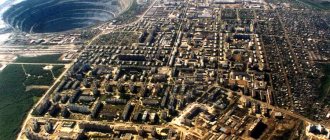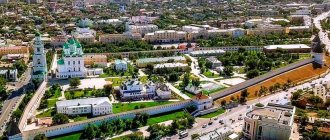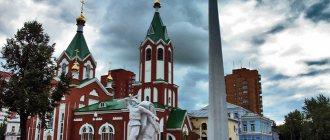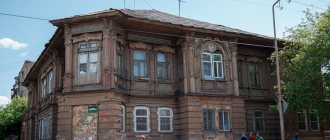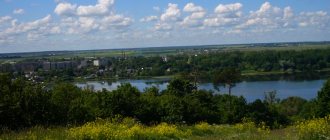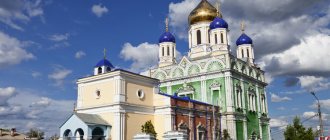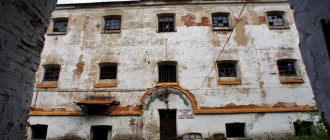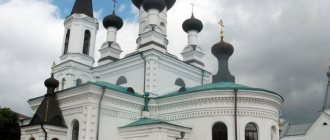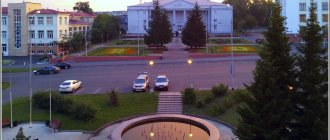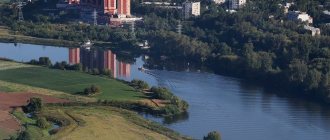Russia \ Volzhsky \ Attractions
The city of Volzhsky is one of the largest cities in the Volgograd region, as well as a large industrial center of the Lower Volga region with a population of 314.4 thousand people. The city is located on the bank of Akhtuba, 20 km from Volgograd. According to the results of the all-Russian competition “The most comfortable city in Russia”, held in 2004, the city of Volzhsky was awarded the title of the greenest city among cities with a population of up to 500,000 inhabitants. Due to the fact that the city does not have such a long history, the attractions of Volzhsky are relatively young; most of the interesting places in the city are not even 50 years old.
The construction of Volzhsky is inextricably linked with the construction of the Volzhskaya hydroelectric station: it was the creation of a hydroelectric power station that served as the impetus for the construction of Volzhsky. The oldest building in the city is a hundred-year-old school, which currently houses an art gallery. Volga residents relax on Lenin Square, VGS Park and Fontannaya Street, visit the local history museum and exhibition hall. There are many religious attractions in Volzhsky: among all the churches and temples in Volzhsky, the most famous is the Church of St. John the Evangelist. And lovers of culture, history and monumental creativity will be interested in such sights as the Volzhsky monuments. Those interested in industrialism will find the Volzhskaya Hydroelectric Power Station and the old river station.
Transport-geographical location
Located in the south of the Volgograd region, on the Caspian lowland, on the left bank of the Volga River, at the beginning of its left branch - the Akhtuba River, 20 km northeast of Volgograd.
The Caspian highway (Moscow - Astrakhan) passes through the city, and the Volzhsky - Samara highway originates here. Railway station (1964; electrified in 2003) on the Volgograd – Astrakhan line. River port (freight transportation: transit and local; structural division of the Volgograd river port). Tram (1963).
History: various versions
The city has its own interesting history, and, despite its rather young age, already has its own myths and legends.
According to one of them, it is believed that the emergence of the city of Volzhsky took place on the site of an impoverished village called Bezrodnoye. Such a settlement actually existed, but at the end of the Second World War it was almost completely destroyed.
During the Battle of Stalingrad, several hospitals and army headquarters, observation posts of artillery units were located in the surrounding area, and reserve units were also formed. Therefore, enemy aviation showed special attention to the Volga region.
But, if we go back to the origins, these desert regions have a much more ancient history. They were indeed once inhabited. And evidence of this was the objects found during the construction of the 36th quarter.
A bronze cup depicting eagles, medals dedicated to Peter I and Alexander Nevsky, a plaque with the image of the coat of arms of the Astrakhan province and the inscription “Volost Judge” were found in the pits; burials and burial mounds were also discovered.
In the Trans-Volga steppe there were traces of the presence of Asian and European peoples - the Polovtsians, Khazars and Pechenegs. Perhaps one of the most memorable periods was the time when Tatar-Mongol tribes lived here. In 1240, on the banks of the Volga, Khan Batu created the state of the Golden Horde, the capital of which was the city of Sarai-Batu. After some time, another khan, Berke, moved the capital to the banks of the river. Akhtuba and gave her the name Sarai-Berke.
The city was the richest, with a population of many thousands, many houses were built and a water supply system was created. The city stretches from the place where modern Volzhsky is located to the Tsarev farm in the Leninsky district - here the village of Saray remains as a memory of former times. In 1395, Tamerlane defeated the Golden Horde and burned its capital to the ground. The once rich region suffered terrible desolation.
These lands began to belong to the Russian state around the middle of the 16th century.
The official version of the origin of s. Bezrodnoye is as follows: it was one of the first where daring Cossacks and fugitive freedom-loving peasants settled. Folk legends say that the village arose in 1607, after an unsuccessful uprising against Vasily Shuisky took place. Residents of Tsaritsyn, trying to avoid reprisals, fled across the Volga to the banks of the Akhtuba River, founding the Upper Bezrodny town here.
These lands were visited by Stepan Razin, Dmitry Donskoy, Alexander Suvorov, Peter I, Alexander Nevsky and Leo Tolstoy. Today, a clear memory of the village. Bezrodny is the oldest building in the city - this is a school that was built in 1881. With their own funds, residents of the village, which was considered prosperous, erected a school building on the high Akhtubinsky bank, in the very center of the village.
The famous underground passages were created in the village. Bezrodny since about 1860. It is believed that they were dug by a sect of schismatic Enochites, which was quite active here, and rumors about it circulated throughout the Lower Volga.
But their very first founder was the Bezrodno cave dweller and false preacher, Andrei Lukyanov, a peasant from the Verkhneakhtubinsk village, which belongs to the Astrakhan diocese. This man, around 1860, decided to spread the fame of his supposedly pious and godly life.
Moving half a mile away from his village, he settled in the mills on the mountain, dug himself a dugout, lived and prayed in it. A little later, wanderers began to come to him, with whom he held conversations and gave instructions. He worshiped Saint Enoch, which is why the sect that was subsequently formed received its name.
Some of the believers who came to the elder even stayed with him. He tested them with patience and labor, forcing them to work in his house. Meanwhile, underground, he dug a hole, made a secret door and retired there for whole days. Soon he equipped a spacious cave, hung lamps, arranged expensive icons, and placed a reader reading the Psalter in front of them.
Anyone who sought solitude was allowed into this chapel. The rumor about these caves quickly spread throughout the neighboring villages, and people flocked to them. Caves were dug intensively, and a fairly large community was formed. Its members stopped attending the official Orthodox Church. The cave founder read many texts from the psalter, giving them his own interpretation.
Over the course of 10 years, the caves turned into huge premises, reminiscent of those in Kyiv. More and more people came here, the elder had his own associates who were his disciples. He promised all the new arrivals that on a certain day and hour of the “Great Descent” they would all be taken to heaven by Saint Enoch.
Initiation into the sect took place in the form of a ritual. Gradually, the illegal actions committed by the elder became known - he collected contributions from everyone joining the sect, robbed a pilgrim from Astrakhan who decided to visit him, before going with a lot of money to Jerusalem to venerate the Holy Sepulcher, patronized the fornication that occurred among those living in caves.
He did not hesitate to travel to nearby villages with requests for charity, and believers donated money, bread, timber, and some simply worked for the elder for free. The authorities banned him and his followers from their activities, and the most ardent supporters were exiled to Poland until 1905. The cave digger himself was assigned to the Suzdal Spaso-Efimovsky Monastery under the strict supervision of the abbot, where he subsequently died.
Afterwards, the Church of All Saints was built on the site of the caves, consecrated in September 1891. The underground passages were destroyed, they continued to self-destruct during the construction of residential buildings and, of course, posed a danger to people. In the sixties, during the construction of some blocks, it was even necessary to do intra-block redevelopment of houses.
During the excavation work, some underground passages were studied; a granite foundation and the remains of brick walls were found in them - all that remained of the destroyed church. In the pit of one of the houses, human remains were found in a wooden coffin, and a cross lay there.
Surveyors, if possible, studied the remaining parts of the passages, but then in the very young city there was no museum or local history scientists for whom all these finds could be of value. Therefore, it was decided to strengthen the underground passages and fill them with soil.
By the beginning of the 20th century, the village of Bezrodnoye was a large and fairly prosperous settlement with a 200-year history and a population of 12,000. By 1917, power was concentrated in the hands of clergy, merchants and rich peasants.
These segments of the population created a shipping partnership, they owned a monopoly on the shipping route from Prishib (now Leninsk) to Tsaritsyn, they freely engaged in the delivery and sale of goods, and were also the owners of windmills.
Science and education
Volzhsky Institute of Economics, Pedagogy and Law (2000); branches of Russian universities: Polytechnic Institute (1965; branch of Volgograd State Technical University; in 2015 it included the Institute of Construction and Technology, 1954 - the oldest university in the city), Humanitarian Institute (1992; branch of Volgograd State University), branches of the Moscow Energy Institute (1995 ), International Law Institute (1999; Moscow), etc.
Central City Library (1957).
Popular message topics
- Homoptera insects
Homoptera insects are of little benefit to humans. They are capable of destroying crops and carrying a variety of, sometimes even fatal, diseases. There are 30 thousand species of these insects. - Didactic games
Didactics (from ancient Greek “instructing”) is directly related to upbringing and education. Ever since a person consciously began to pass on his knowledge to the younger generation, the need for training arose. - Proper nutrition
In order for the human body to function as usual, it needs to eat properly. Proper nutrition is the rational consumption of foods, selected specifically for the parameters of your body.
Farm
The basis of the city's economy is industrial production. Leading industries: electric power, ferrous metallurgy, chemical, mechanical engineering and food processing. The main power generating capacities: Volzhskaya HPP (1961; lower in the Volga cascade; capacity 2671 MW), gas and oil CHPP-1 (1962; 541 MW) and CHPP-2 (1988; 240 MW). Among the largest industrial enterprises are pipe-rolling plants: Volzhsky Pipe (1970; one of the country's leading producers of steel pipes), Profil-Akras Pipe Plant named after. V.V. Makarova (1991) and pipe-profile (2005; profile pipes and small-diameter pipes); (1964; aniline, methionine, carbon disulfide, flotation reagents, gasoline additives, etc.), tire "Voltyre-Prom" (1964; until 1992 named after the 50th anniversary of the formation of the USSR), regenerative tire repair (1961), "Volzhskrezinotekhnika" ( high-pressure rubber hoses), Gazprom Khimvolokno (1966; cord and technical fabrics), Polyplastic Povolzhye (polyethylene pipes), nitrogen-oxygen, EKTOS-Volga (high-octane additives for motor gasoline), bearing (1961) holding "Volgabus" (history dates back to 1993, current status since 2008; production of buses for various purposes of the "Cityrhythm" brand; capacity of about 500 units per year), car mufflers, "Meteor" (quartz resonators), "Energotekhmash" (prefabricated collapsible residential complexes), "Volgograd Aluminum Company - Powder Metallurgy" ("Valcom-PM"; aluminum powders and powders), steel structures, "Volga Industrial Complex" (gas cylinders and metal containers), asbestos technical products and abrasive. The food-flavoring industry is represented by bakeries, dairy and cheese-making plants, a brewery and other enterprises.
History and modernity of the city of Volzhsky. Getting to know the city. Interesting facts and events.
Volzhsky is a city subordinate to the regional center - Volgograd. He is a satellite of the hero city, located on the other side of the river. Volga from him. The total area of the city is divided into 42 microdistricts and 30 blocks, which are numbered digitally and alphabetically.
In general, the numbering of houses here is unusual - it is double. The fact is that in Volzhsky it is customary to number houses not only by microdistricts, but also by streets. On one of the streets - named after. Pushkin there is a unique house with double numbering of apartments. Although, regardless of which address is indicated on the postal item, the letter will definitely arrive.
But as far as registration is concerned, everything is strict for local residents - the passport indicates the address only on the street, since this option is recognized as official. But the “mysteries” of Volga addresses do not end there - for example, houses located at street intersections can even boast triple numbers.
They receive numbering for both streets and, in addition, for the block. For Volga residents, this is a typical situation - taxi drivers or dispatchers of various services, out of habit, clarify: what is the house number on the street?
Although modernity is taking its toll, the use of addresses by neighborhood has become less and less used lately. There are 57 city streets in total. The largest of them are Lenin Avenue, Karbysheva and Mira streets. The longest, passing through almost the entire Volzhsky - st. Pushkin.
Fontannaya is considered one of the most beautiful; it was here that the first fountain in the entire city began operating, and is still in operation today. This street is adjacent to Komsomolskaya Square (aka Palace Square) and a cultural park.
All together are among the most valuable, from a historical point of view, urban places. Some streets have the same names - here two streets are called Oktyabrskaya (one in the village of Rabochy), and two more are consonant with the city - st. Volzhskaya in the villages of Krasnooktyabrsky and Rabochy.
